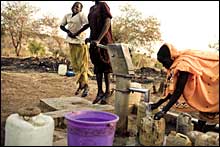A conceptual framework for FAO
 Given both the importance of water for agriculture and food production, and the responsibility of agriculture to better account for water withdrawals and the subsequent impacts on water quality, FAO has undertaken a review of its water programme in order to propose a more effective and more strategic response to the growing issue of water scarcity.
Given both the importance of water for agriculture and food production, and the responsibility of agriculture to better account for water withdrawals and the subsequent impacts on water quality, FAO has undertaken a review of its water programme in order to propose a more effective and more strategic response to the growing issue of water scarcity.
The programme is necessarily bound by the Organization’s agricultural and rural livelihoods focus and has to reflect the specific food and agriculture concerns of FAO’s member countries. Nevertheless, this must be done within a realistic and responsible water management context, requiring a multi-disciplinary and cross sectoral approach. The competition for water, the requirement to mitigate environmental externalities, account for resource costs, and the recognition of the productive value of environmental services of water are all shaping the local and global discourse over water allocations and environmental regulation. Agriculture will continue to be the most important user of water in many countries, and therefore needs to be brought into the discourse on the basis of a well articulated framework for evaluation of impact, negotiation of allocation and management response towards increased productivity of water in agriculture.

This will necessarily require system boundaries to be defined and key quantitative indicators of performance to be applied. First, agricultural water use and management need to be understood in all its dimensions. The technical aspects of crop production, aquaculture, livestock watering, forestry and watershed management need to be adequately represented and diagnosed. Second, the overall contribution of water use to agricultural productivity, rural livelihoods and environmental externalities must be correctly analysed through commonly accepted, but scientifically robust, definitions and water accounting methods. This involves a consideration of water use efficiency at field and irrigation scheme level, engages additional productivity dimensions, and extends to macro-economic assessments of the water-related agricultural economy to GDP and global trade, in a continuum from the point of direct water withdrawal to the point of effective consumption in foodstuffs and industrial commodities. Third, the institutional (including legal) implications of raising the productive level of the water economy must be fully addressed and the agriculture sector adequately aligned and compliant with competing users and water regulators.
The Comprehensive Assessment of Water Management in Agriculture, published in 2007, provides an extensive review of main issues related to water in agriculture and response options in terms of policies and management. Through its extensive consultation process, involving up to 700 experts in the field, it is a reference for future FAO work in water and agriculture. Modalities of implementation, priorities for FAO action and the overall framework in which such action should take place remain to be defined.
